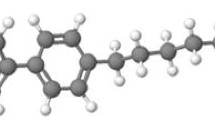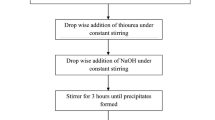Abstract
This article presents a description of a method of oleic acid separation from quantum dot (QD) solution. The oleic acid is a good stabilizer for CdSe/CdS/ZnS QD solution. QDs are an interesting material for fabricating the optoelectronic devices. The main disadvantage in QDs’ presence is an excess unbounded surfactant of the oleic acid. Oleic acid ligands have some defect on the morphology and modify the electronic structure of thin film QDs. One of the methods that allow to remove this excess surfactant is a separation by using high-density polyethylene (HDPE) membrane with thermal treatment. The thermal treatment has an effect on the separation of surfactants and the period of process. The changing in the number of surfactants in QD solution during various conditions is recorded by Langmuir-Blodgett (LB) technique. The QD monolayers are deposited on solid substrate by using Langmuir-Schaefer method. The changing in morphology is studied by atomic force microscopy (AFM). Photoluminescence (PL) spectra and photoconductivity properties of QDs are studied. The change in the surface pressure during separation was recorded. The conductivity enhancement and shifting of PL spectra were observed. It is related to decreasing number of an excess surfactant and changing structure of QDs’ outer shell.





Similar content being viewed by others
References
Gubbala, S., Chakrapani, V., Kumar, V., & Sunkara, M. K. (2008). Band-edge engineered hybrid structures for dye-sensitized solar cells based on SnO2 nanowires. Advanced Functional Materials, 18, 2411–2418.
Kudo, N., Shimazaki, Y., Ohkita, H., Ohoka, M., & Ito, S. (2007). Organic–inorganic hybrid solar cells based on conducting polymer and SnO2 nanoparticles chemically modified with a fullerene derivative. Solar Energy Materials and Solar Cells, 91(13), 1243–1247. doi:10.1016/j.solmat.2006.11.019.
Zhang, S., Cyr, P. W., McDonald, S. A., Konstantatos, G., & Sargent, E. H. (2005). Enhanced infrared photovoltaic efficiency in PbS nanocrystal/semiconducting polymer composites: 600-fold increase in maximum power output via control of the ligand barrier. Applied Physics Letters, 87, 233101.
Thangadurai, P., Balaji, S., & Manoharan, P. T. (2008). Surface modification of CdS quantum dots using thiols—structural and photophysical studies. Nanotechnology, 19, 43 435708.
Aldana, J., Wang, Y. A., & Peng, X. (2001). Photochemical instability of CdSe nanocrystals coated by hydrophilic thiols. Journal of the American Chemical Society, 123, 8844–8850.
Silva, F. O., Carvalho, S. M., Mendonça, R., Macedo, A. W., Balzuweitm, K., Reiss, P., & Schiavon, M. A. (2012). Effect of surface ligands on the optical properties of aqueous soluble CdTe quantum dots. Nanoscale Research Letters, 7, 536.
Justo, Y., Moreels, I., Lambert, K., & Hens, Z. (2010). Langmuir–Blodgett monolayers of colloidal lead chalcogenide quantum dots: morphology and photoluminescence. Nanotechnology, 21, 295606.
Baruah, L., & Nath, S. S. (2013). Oleic acid–capped CdTe quantum dots and their applications as nano-LED. Emerging Materials Research, 2(4), 186–190.
Oertel, D. C., & Bawendia, M. G. (2005). Photodetectors based on treated CdSe quantum-dot films. Applied Physics Letters, 87, 213505.
Chen, J., Lei, W., Li, C., Zhang, Y., Cui, Y., Wang, B., & Deng, W. (2011). Flexible quantum dot sensitized solar cell by electrophoretic deposition of CdSe quantum dots on ZnO nanorods. Physical Chemistry Chemical Physics, 13, 13182–13184.
Rubingera, C. P. L., Moreira, R. L., Cury, L. A., Fontes, G. N., Neves, B. R. A., Meneguzzi, A., & Ferreira, C. A. (2006). Langmuir–Blodgett and Langmuir–Schaefer films of poly (5-amino-1-naphthol) conjugated polymer. Applied Surface Science, 253, 543–548. doi:10.1016/j.apsusc.2005.12.096.
Liu, Y., & Liu, M. (2002). Monolayers Langmuir–Schaefer films and acidichromism of a nonamphiphilic acetone derivative containing carbazole. New Journal of Chemistry, 26, 180–183. doi:10.1039/B105694H.
Gorbachev, I. A., Goryacheva, I. Y., & Glukhovskoy, E. G. (2016). Investigation of multilayers structures based on the Langmuir-Blodgett films of CdSe/ZnS quantum dots. BioNanoSci, 6(2), 153–156. doi:10.1007/s12668-016-0194-0.
Qi, D., Fischbein, M., & Drndic, M. (2005). Efficient polymer-nanocrystal quantum-dot photodetectors. Applied Physics Letters, 86, 093103. doi:10.1063/1.1872216.
Ootsuka, T., Liu, Z., Osamura, M., Fukuzawa, Y., Kuroda, R., Suzuki, Y., Otogawa, N., Mise, T., Wang, S., Hoshino, Y., Nakayama, Y., Tanoue, H., & Makita, Y. (2005). Studies on aluminum-doped ZnO films for transparent electrode and antireflection coating of β-FeSi2 optoelectronic devices. Thin Solid Films, 476, 30–34. doi:10.1016/j.tsf.2004.06.145.
Huy, B. T., Seo, M. H., Lim, J. M., Shin, D. S., & Lee, I. L. (2011). A systematic study on preparing CdS quantum dots. Journal of the Korean Physical Society, 59(5), 3293–3299. doi:10.3938/jkps.59.3293.
Liu, L., Peng, Q., & Li, Y. (2008). An effective oxidation route to blue emission CdSe quantum dots. Inorganic Chemistry, 47(8), 3182–3187. doi:10.1021/ic702203c.
Sapra, S., Mayilo, S., Klar, T. A., Rogach, A. L., & Feldmann, J. (2007). Bright white-light emission from semiconductor nanocrystals: by chance and by design. Advanced Materials, 19, 569–572. doi:10.1002/adma.200602267.
Reiss, P., Protiˋere, M., & Li, L. (2009). Core/shell semiconductor nanocrystals. Small, 5, 154–168. doi:10.1002/smll.200800841.
Hai, L. B., Nghia, N. X., Nga, P. T., Chinh, V. D., Trang, N. T. T., & Hanh, V. T. H. (2009). Preparation and spectroscopic investigation of colloidal CdSe/CdS/ZnS core/multishell nanostructure. Journal of Experimental Nanoscience, 4(3), 277–283. doi:10.1080/17458080802178619.
Gao, B., Shen, C., Yang, Y., Yuan, S., & Chen, G. (2014). Green synthesized CdSe quantum dots capped by 3-mercaptopropionic acid sensitized solar cells. Springer Proceedings in Physics, 155, 9–17. doi:10.1007/978-3-319-05521-3_2.
Acknowledgments
The work is supported by a grant of the Russian Science Foundation RSF-14-12-00275 and National Research Saratov State University.
Author information
Authors and Affiliations
Corresponding author
Electronic Supplementary Material
ESM 1
(DOCX 1620 kb)
Rights and permissions
About this article
Cite this article
Al-Alwani, A.J., Chumakov, A.S., Gorbachev, I.A. et al. Influence of Thermal Separation of Oleic Acid on the Properties of Quantum Dots Solutions and Optoelectronic of Their Langmuir Monolayers. BioNanoSci. 7, 496–500 (2017). https://doi.org/10.1007/s12668-017-0412-4
Published:
Issue Date:
DOI: https://doi.org/10.1007/s12668-017-0412-4




